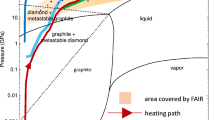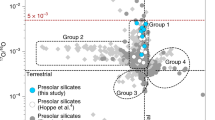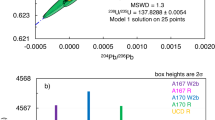Abstract
Diamond grains are the most abundant presolar grains found in primitive meteorites1,2,3. They formed before the Solar System, and therefore provide a record of nuclear and chemical processes in stars and in the interstellar medium1,2,3. Their origins are inferred from the unusual isotopic compositions of trace elements—mainly xenon1,2,3,4—which suggest that they came from supernovae. But the exact nature of the sources has been enigmatic, as has the method by which noble gases were incorporated into the grains. One observation is that different isotopic components are released at different temperatures when the grains are heated, and it has been suggested that these components have different origins. Here we report results of a laboratory study that shows that ion implantation (previously suggested on other grounds5,6) is a viable mechanism for trapping noble gases. Moreover, we find that ion implantation of a single isotopic composition can produce both low- and high-temperature release peaks from the same grains. We conclude that both isotopically normal and anomalous gases may have been implanted by multiple events separated in space and/or time, with thermal processing producing an apparent enrichment of the anomalous component in the high-temperature release peak. The previous assumption that the low- and high-temperature components were not correlated may therefore have led to an overestimate of the abundance of anomalous argon and krypton, while obscuring an enhancement of the light—in addition to the heavy—krypton isotopes.
This is a preview of subscription content, access via your institution
Access options
Subscribe to this journal
Receive 51 print issues and online access
$199.00 per year
only $3.90 per issue
Buy this article
- Purchase on Springer Link
- Instant access to full article PDF
Prices may be subject to local taxes which are calculated during checkout


Similar content being viewed by others
References
Anders, E. & Zinner, E. Interstellar grains in primitive meteorites: diamond, silicon carbide, and graphite. Meteoritics 28, 490–514 (1993).
Ott, U. Interstellar grains in meteorites. Nature 364, 25–33 (1993).
Zinner, E. in Astrophysical Implications of the Laboratory Study of Presolar Materials (eds Bernatowicz, T. J. & Zinner, E.) 3–26 (American Institute of Physics, Woodbury, New York, 1997).
Huss, G. R. & Lewis, R. S. Noble gases in presolar diamonds I: Three distinct components and their implications for diamond origins. Meteoritics 29, 791–810 (1994).
Lewis, R. S., Tang, M., Wacker, J. G., Anders, E. & Steel, E. Interstellar diamonds in meteorites. Nature 326, 160–162 (1987).
Verchovsky, A. B. et al. C, N, and noble gas isotopes in grain size separates of presolar diamonds from Efremovka. Science 281, 1165–1168 (1998).
Daulton, T. L., Eisenhour, D. D., Bernatowicz, T. J., Lewis, R. S. & Buseck, P. R. Genesis of presolar diamonds: comparative high-resolution transmission electron microscopy study of meteoritic and terrestrial nano-diamonds. Geochim. Cosmochim. Acta 60, 4853–4872 (1996).
Tielens, A. G. G. M., Seab, C. G., Hollenbach, D. J. & McKee, C. F. Shock processing of interstellar dust: diamonds in the sky. Astrophys. J. 319, L109–L113 (1987).
Nuth, J. A. III & Allen, J. E. Jr Supernovae as sources of interstellar diamonds. Astrophys. Space Sci. 196, 117–123 (1992).
Ozima, M. & Mochizuki, K. Origin of nanodiamonds in primitive chondrites: (1) Theory. Meteoritics 28, 416–417 (1993).
Matsuda, J. -I., Kusumi, A., Yajima, H. & Syono, Y. Noble gas studies in diamonds synthesized by shock loading in the laboratory and their implications on the origin of diamonds in ureilites. Geochim. Cosmochim. Acta 59, 4939–4949 (1995).
Matsuda, J. -I., Fukunaga, K. & Ito, K. Noble gas studies in vapor-growth diamonds: comparison with shock-produced diamonds and the origin of diamonds in ureilites. Geochim. Cosmochim. Acta 55, 2011–2023 (1991).
Frick, U., Mack, R. & Chang, S. Noble gas trapping and fractionation during synthesis of carbonaceous matter. Proc. Lunar. Planet. Sci. Conf. X, 1961–1973 (1979).
Bernatowicz, T. J. & Fahey, A. J. Xe isotopic fractionation in a cathodeless glow discharge. Geochim. Cosmochim. Acta 50, 445–452 (1986).
Weigel, A. et al. Noble gas systematics in planetary atmospheres: Simulation of fractionation mechanisms using ion implantation. Lunar Planet. Sci. [CD-ROM] XXIX, abstr. 1900 (1998).
Bernatowicz, T. J. & Hagee, B. E. Isotopic fractionation of Kr and Xe implanted in solids at very low energies. Geochim. Cosmochim. Acta 51, 1599–1611 (1987).
Ponganis, K. V., Graf, T. & Marti, K. Isotopic fractionation in low-energy ion implantation. J. Geophys. Res. 102, 19335–19343 (1997).
Futagami, T., Ozima, M., Nagai, S. & Aoki, Y. Experiments on thermal release of implanted noble gases from minerals and their implications for noble gases in lunar soil grains. Geochim. Cosmochim. Acta 57, 3177–3194 (1993).
Koscheev, A. P., Gromov, M. D., Herrmann, S. & Ott, U. Trapping and isotope fractionation of noble gases in synthetic analog of presolar diamond grains. Lunar Planet. Sci. [CD-ROM] XXXI, abstr. 1551 (2000).
Verchovsky, A. B., Wright, I. P., Fisenko, A. V., Semjonova, L. F. & Pillinger, C. T. Ion implantation into presolar diamonds: experimental simulation. J. Conf. Abstr. [CD-ROM] 5, abstr. 1050 (2000).
Lyamkin, A. I. et al. Production of diamonds from explosives. Sov. Phys. Dokl. 33, 705–706 (1988).
Koscheev, A. P. & Ott, U. Mechanism of noble gas release during pyrolysis of nanodiamond grains. Meteorit. Planet. Sci. 35, A92 (2000).
Clayton, D. D. Origin of heavy xenon in meteoritic diamonds. Astrophys. J. 340, 613–619 (1989).
Howard, W. M., Meyer, B. S. & Clayton, D. D. Heavy-element abundances from a neutron burst that produces Xe-H. Meteoritics 27, 404–412 (1992).
Ott, U. Interstellar diamond xenon and timescales of supernova ejecta. Astrophys. J. 463, 344–348 (1996).
Guillois, O., Ledoux, G. & Reynaud, C. Diamond infrared emission bands in circumstellar media. Astrophys. J. 521, L133–L136 (1999).
Frick, U. Anomalous krypton in the Allende meteorite. Proc. Lunar Sci. Conf. VIII, 273–292 (1977).
Huss, G. R., Ott, U. & Koscheev, A. P. Implications of ion-implantation experiments for understanding noble gases in presolar diamonds. Meteorit. Planet. Sci. 35, A79–A80 (2000).
Ziegler, J. F., Biersack, J. P. & Littmark, U. The Stopping Range of Ions in Solids (Pergamon, Tarrytown, New York, 1985).
Schelhaas, N., Ott, U. & Begemann, F. Trapped noble gases in unequilibrated ordinary chondrites. Geochim. Cosmochim. Acta 54, 2869–2882 (1990).
Acknowledgements
We thank S. Herrmann for assisting with the noble-gas measurements, G.R. Huss and A.B. Verchovsky for discussions, and R.S. Lewis and A.P. Meshik for comments on the manuscript. This work was partially supported by the Russian Foundation of Basic Science and by the German DFG.
Author information
Authors and Affiliations
Corresponding author
Rights and permissions
About this article
Cite this article
Koscheev, A., Gromov, M., Mohapatra, R. et al. History of trace gases in presolar diamonds inferred from ion-implantation experiments. Nature 412, 615–617 (2001). https://doi.org/10.1038/35088009
Received:
Accepted:
Issue Date:
DOI: https://doi.org/10.1038/35088009
This article is cited by
-
Ion implantation in nanodiamonds: size effect and energy dependence
Scientific Reports (2018)
-
Presolar Grains in Meteorites and Their Compositions
Space Science Reviews (2007)
-
The Influence of Radiation Defects in Meteoritic Nanodiamond on the Elemental Composition of the P3 Noble Gas Component
Solar System Research (2005)
Comments
By submitting a comment you agree to abide by our Terms and Community Guidelines. If you find something abusive or that does not comply with our terms or guidelines please flag it as inappropriate.



